The U.N.'s nuclear watchdog says Japan can release nuclear waste water into the ocean
MANILA, Philippines — The International Atomic Energy Agency has approved a plan by Japan to release more than a million tons of treated nuclear waste water from the destroyed Fukushima power plant into the ocean, despite vehement international opposition.
In a report released Tuesday, the IAEA said it has concluded after a two-year assessment that the plan is "consistent with relevant international safety standards" and that while societal, political and environmental concerns have been raised, the discharged water "will have negligible radiological impact on people and the environment."
IAEA Director General Rafael Mariano Grossi traveled to Tokyo to present the findings to Japanese Prime Minister Fumio Kishida. During a press conference, Grossi said the United Nations' nuclear watchdog would monitor the discharge from on-site.
"This will ensure the relevant international safety standards continue to be applied throughout the decades-long process laid out by the Government of Japan and TEPCO [Tokyo Electric Power Company]," Grossi told reporters at the Japan National Press Club on Tuesday.
The plan was first presented in 2021 by Japan's government, its Nuclear Regulation Authority and TEPCO, the operators of the destroyed Fukushima Daiichi Nuclear Power Station. All of them maintain that the process is safe.
The water, which was used to cool the fuel rods of the plant in 2011 following meltdowns in three of its reactors, will be treated and released into the Pacific Ocean over the next 30-40 years. The disaster was caused by tsunami waves triggered by a magnitude 9.0 earthquake.
Japan has not yet said when the water release will begin, as it was waiting for approval from the IAEA.
The plan has drawn significant criticism from the scientific community, with many scientists saying they are not convinced by the Japanese government and TEPCO's assertions that it is safe — that the treated wastewater will be essentially diluted in the ocean.
Robert Richmond, a biologist with the University of Hawaii and one of the five experts commissioned by the Pacific Islands Forum to study the plan, said scientists in Japan have not provided enough evidence that harmful elements won't be released into the ocean.
"There are major gaps in the critical information that's necessary for us to make the final determination," said Richmond, who notes that the panel has raised this and other issues with the Japanese government, but to no avail.
He says this is problematic because harmful elements can bind to the ocean sediment and living organisms, potentially damaging their DNA and causing mutations. "We are unanimous in our view that this has not been proven to be safe," Richmond says.
The plan has also drawn criticism both domestically as well as internationally, from neighboring countries such as South Korea, the Philippines and China. Their argument is that this is a transboundary issue — that waste water released by Japan is not going to just stay in and around Japan.
"I would like to stress that Japan's release of treated nuclear-contaminated water from the Fukushima plant concerns the global marine environment and public health, which is not a private matter for the Japanese," Chinese Foreign Ministry spokesperson Mao Ning said earlier this year.
Further afield, many Pacific Island nations and their residents have also voiced full-throated opposition, citing a threat to their livelihoods and ocean way of life. Meanwhile, many across the Pacific say the waste water release plan is a continuation of the Pacific's traumatizing relationship with nuclear technology and harkens to a past when larger powers used their islands — and their people — as collateral damage to further their nuclear ambitions.
Bedi Racule, a nuclear justice advocate based in Fiji, says she was shocked when she found out about Japan's nuclear waste release plan because she thought nuclear issues were part of the past. Racule is from the Marshall Islands, where the United States tested nearly 70 atomic bombs over 12 years — including Operation Castle Bravo in 1954, the first test of the hydrogen bomb.
"[The shock] has been a really common experience for young people in the Pacific who often don't realize even how many tests were done in the Pacific, the ongoing health and environmental impacts and how nuclear colonialism continues today through the development of nuclear power and nuclear weapons," she said.
However, not all Pacific island nation leaders are against the plan. The leaders of Micronesia and Papua New Guinea have recently come out in support of it, citing trust in the Japanese government to uphold safety regulations.
Disclaimer: The copyright of this article belongs to the original author. Reposting this article is solely for the purpose of information dissemination and does not constitute any investment advice. If there is any infringement, please contact us immediately. We will make corrections or deletions as necessary. Thank you.







